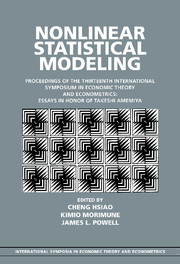 Nonlinear Statistical Modeling
Nonlinear Statistical Modeling Published online by Cambridge University Press: 05 June 2012
Introduction
The object of this chapter is the investigation of a particular approach to estimation of the parameters of bivariate (and multivariate) latent dependent variable models under weak assumptions on the distributions of the unobservable error terms. The class of latent variable models considered includes a number of microeconometric applications, including the censored sample selection models of Gronau (1973) and Heckman (1974), the disequilibrium regression model with observed regimes proposed by Fair and Jaffee (1972), and other simultaneous Tobit models. A survey of such models can be found in Chapter 10 of Amemiya (1985).
A common feature of these models is the noninvertibility of the transformation from the unobserved error terms to the observed dependent variables; since the error terms therefore cannot be written as a known function of observable random variables and the unknown parameters, zero mean and other moment restrictions on the errors are inadequate to identify the parameters of interest. Another feature common to these models, which distinguishes them from multinomial and other discrete response models, is the continuous distribution of the dependent variable in one (or more) equation of interest on some subset of its support. Unlike discrete response models, where some normalization of the parameter vector is typically required, the units of the regression coefficients relating the dependent variable to the regressors are well defined, and the scale of the parameter vector should (in principle) be identified.
To save this book to your Kindle, first ensure [email protected] is added to your Approved Personal Document E-mail List under your Personal Document Settings on the Manage Your Content and Devices page of your Amazon account. Then enter the ‘name’ part of your Kindle email address below. Find out more about saving to your Kindle.
Note you can select to save to either the @free.kindle.com or @kindle.com variations. ‘@free.kindle.com’ emails are free but can only be saved to your device when it is connected to wi-fi. ‘@kindle.com’ emails can be delivered even when you are not connected to wi-fi, but note that service fees apply.
Find out more about the Kindle Personal Document Service.
To save content items to your account, please confirm that you agree to abide by our usage policies. If this is the first time you use this feature, you will be asked to authorise Cambridge Core to connect with your account. Find out more about saving content to Dropbox.
To save content items to your account, please confirm that you agree to abide by our usage policies. If this is the first time you use this feature, you will be asked to authorise Cambridge Core to connect with your account. Find out more about saving content to Google Drive.